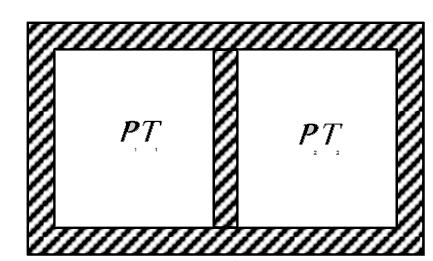In an adiabatic change, the pressure p and temperature T of a diatomic gas are related by the relation p∝Tα, where α equals
(a) 1.67
(b) 0.4
(c) 0.6
(d) 3.5
The correct Answer is:D
To solve the problem, we need to find the value of alpha in the relation P∝Tα for a diatomic gas undergoing an adiabatic change.
1. Understand the Adiabatic Process:
In an adiabatic process, there is no heat exchange with the surroundings. For an ideal gas, the relationship between pressure (P), volume (V), and temperature (T) can be described using the adiabatic condition.
2. Use the Adiabatic Relation:
The general relation in an adiabatic process for an ideal gas is given by:
P⋅Vγ=constant
where γ=CpCv is the heat capacity ratio.
3. Relate Pressure and Temperature:
For an ideal gas, we can also express the relationship between pressure and temperature during an adiabatic process as:
P⋅Tγγ−1=constant
This implies that:
P∝Tγγ−1
4. Identify Gamma for Diatomic Gas:
For a diatomic gas, the value of γ is typically 1.4.
5. Calculate Alpha:
From the relation derived, we can equate:
α=γγ−1
Substituting γ=1.4:
α=1.41.4−1=1.40.4=3.5
6. Conclusion:
Therefore, the value of α is 3.5.
Final Answer:
α=3.5
In an adiabatic process, there is no heat exchange with the surroundings. For an ideal gas, the relationship between pressure (P), volume (V), and temperature (T) can be described using the adiabatic condition.
The general relation in an adiabatic process for an ideal gas is given by:
P⋅Vγ=constant
where γ=CpCv is the heat capacity ratio.
For an ideal gas, we can also express the relationship between pressure and temperature during an adiabatic process as:
P⋅Tγγ−1=constant
This implies that:
P∝Tγγ−1
For a diatomic gas, the value of γ is typically 1.4.
From the relation derived, we can equate:
α=γγ−1
Substituting γ=1.4:
α=1.41.4−1=1.40.4=3.5
Therefore, the value of α is 3.5.
α=3.5
Topper's Solved these Questions
- LAWS OF THERMODYNAMICSBook:DC PANDEY ENGLISHChapter:LAWS OF THERMODYNAMICSExercise:Level 1 Objective Questions
Explore 1 Video
- LAWS OF THERMODYNAMICSBook:DC PANDEY ENGLISHChapter:LAWS OF THERMODYNAMICSExercise:Level 1 Subjective
Explore 24 Videos
- LAWS OF THERMODYNAMICSBook:DC PANDEY ENGLISHChapter:LAWS OF THERMODYNAMICSExercise:Level 1 Assertion And Reason
Explore 10 Videos
- LAWS OF MOTIONBook:DC PANDEY ENGLISHChapter:LAWS OF MOTIONExercise:Medical entrances gallery
Explore 39 Videos
- MAGNETIC EFFECT OF CURRENT AND MAGNETISMBook:DC PANDEY ENGLISHChapter:MAGNETIC EFFECT OF CURRENT AND MAGNETISMExercise:Integer type Questions
Explore 10 Videos
Similar Questions
Knowledge Check
In an adiabatic change the pressure and temperature of monoatomic gas are related as P∝Tc where C equal
A2/5B5/2C3/5D5/3
At constant volume , pressure and temperature are related (T0= STP temp.)
View SolutionWhen a polyatomic gas undergoes an adiabatic process, its temperature and volume are related by the equation TVn =constant, the value of n will be
View SolutionOne mole of a gas is enclosed in a cylinde in a cyclinder and occupies a volume of 1.5L at a pressure 1.5 atm. It is subjected to strong heating due to which temperature of the gas increase according to the relation T=αV2, where α is a positive constant and V is volume of the gas.
a. Find the work done by air in increasing the volume of gas to 9L.
b. Draw the P−V diagram of the process.
c. Determine the heat supplied to the gas (assuming γ=1.5).
View SolutionIf P is the pressure and ρ is the density of a gas, then P and ρ are related as :
View SolutionAn ideal gas undergoing adiabatic change has the following pressure-temperature relationship
View SolutionFollowing figure shows on adiabatic cylindrical container of volume V0 divided by an adiabatic smooth piston (area of cross-section = A ) in two equal parts. An ideal gas (Cp/Cy=λ) is at pressure P1 and temperature T1 in left part and gas at pressure P2 and temperature T2 in right part. The piston is slowly displaced and released at a position where it can stay in equilibrium. The final pressure of the two parts will be (Suppose x = displacement of the piston)

View SolutionProve that the pressure and the volume of a degenerate electron gas are related by an equation similar to the Poisson equation, and find the adiabatic index γ=Cp/Cv.
View Solution

